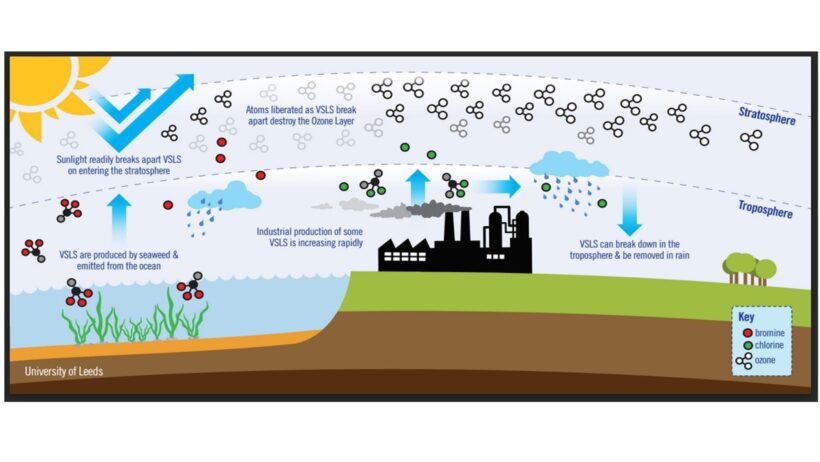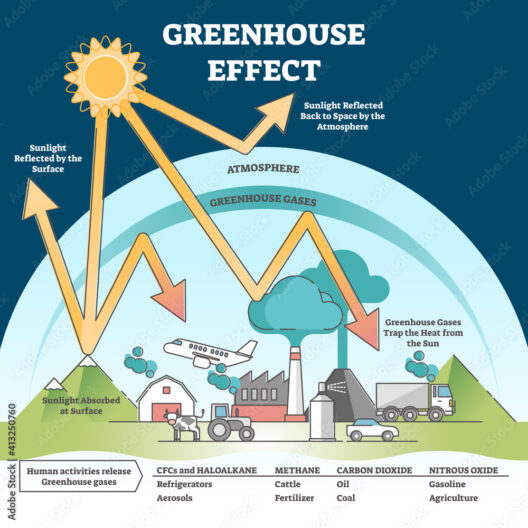Ozone depletion and global warming are two distinct yet interrelated phenomena that have garnered significant attention in recent years. While ozone depletion primarily refers to the thinning of the ozone layer, which shields the Earth from harmful ultraviolet (UV) radiation, global warming pertains to the gradual increase in Earth’s average temperature due to greenhouse gas emissions. Understanding the interplay between these two ecological issues reveals a complex narrative, elucidating how one can exacerbate the other under certain conditions.
To begin with, it is essential to delineate the mechanisms through which ozone depletion occurs. The ozone layer, situated in the stratosphere, comprises molecules of ozone (O3) that absorb the majority of the sun’s harmful UV radiation. The presence of chlorofluorocarbons (CFCs) and other ozone-depleting substances (ODS) released during human activities has led to a significant decline in ozone concentration. Notably, as these compounds ascend into the stratosphere, they undergo photodissociation, releasing chlorine atoms that catalyze the breakdown of ozone.
Meanwhile, global warming is primarily driven by the accumulation of greenhouse gases, such as carbon dioxide (CO2) and methane (CH4), in the atmosphere. These gases trap heat, creating a ‘greenhouse effect’ that contributes to rising temperatures. The relationship between these processes has been a subject of extensive scientific inquiry.
One common observation is that the depletion of the ozone layer may be exacerbating global warming through a variety of mechanisms. First and foremost, the decline in stratospheric ozone can influence atmospheric circulation patterns, ultimately affecting weather and climate systems. The ozone layer plays a crucial role in regulating temperature gradients between the poles and the equator. As ozone diminishes, these gradients can shift, potentially leading to extreme weather events and altering precipitation patterns.
Moreover, ozone depletion contributes to increased ultraviolet radiation reaching the Earth’s surface. Elevated levels of UV radiation can disrupt ecosystems, affecting vegetation growth and phytoplankton populations in the oceans. Phytoplankton, the microscopic plants that inhabit the seas, are foundational to the marine food web and play an essential role in carbon fixation; their decline could, therefore, diminish the ocean’s capacity to sequester atmospheric carbon dioxide, further exacerbating global warming.
The connection between ozone depletion and climate change is further illustrated through feedback loops. For instance, as the planet warms, polar ice caps and glaciers are retreating more rapidly. These regions are home to significant reservoirs of ozone-depleting substances that had previously been trapped in ice. As these substances are released back into the atmosphere, they can accelerate the rate of ozone destruction while simultaneously contributing to the greenhouse gas effect.
Additionally, studies have indicated that there is a complex interaction between greenhouse gases and ozone-depleting substances. Some greenhouse gases can contribute to ozone depletion as well, creating a dual dilemma for policymakers tackling climate change. The rise of new ozone-depleting gases, often found in consumer products, underscores the urgent need for stringent regulations to curb both climate emissions and substances harmful to the ozone layer.
Furthermore, the Montreal Protocol, established in 1987 to phase out CFCs and other harmful chemicals, has had measurable effects on the recovery of the ozone layer. However, the challenge remains that while the measures have led to a gradual healing process, the long-term effects of prior ozone depletion continue to pose risks to global climate stability. Scientists are observing that changes in the stratospheric ozone may have implications for patterns of climate change well into the future, affecting both temperature and precipitation globally.
Analysts argue that employing a dual approach could yield significant co-benefits in combating both climate change and ozone depletion. By addressing greenhouse gas emissions while continuing to phase out ozone-depleting substances, it is possible to facilitate the recovery of the ozone layer and combat climate change simultaneously. This highlights the necessity for an integrated perspective that intertwines these environmental challenges, ensuring that efforts in one area do not adversely impact the other.
In recent research endeavors, scientists have begun to correlate the impacts of ozone hole variations with temperature anomalies across different geographical locations. Observations suggest that the dynamics of the ozone layer can operate as a control mechanism for temperature changes, particularly in the Southern Hemisphere. As the ozone layer recovers, varying hyperthermal responses have been noted, indicating potential adjustments in atmospheric circulation patterns that could either amplify or mitigate ongoing climate challenges.
In conclusion, while ozone depletion and global warming may initially appear as separate issues, their interrelation is profound and complex. The degradation of the ozone layer not only compromises vital UV protection but also intricately weaves into the fabric of global climate dynamics. Addressing these challenges necessitates cohesive global strategies that incorporate understanding across scientific domains, fostering resilient ecosystems and a stable climate for future generations. The urgency of the exploration of this nexus of environmental science is paramount, for the health of the planet and its inhabitants hangs in a delicate balance.








